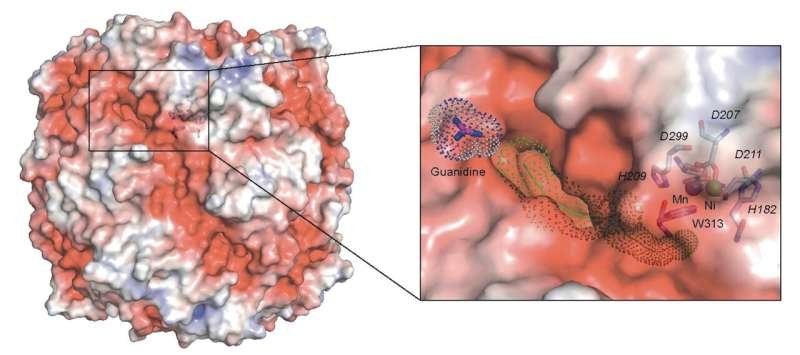
An international research team led by the Centre for Microbiology and Environmental Systems Science (CeMESS) at the University of Vienna has discovered that comammox bacteria, first identified by them in 2015, can grow using guanidine, a nitrogen-rich organic compound, as their sole energy and nitrogen source. This unique ability opens new avenues for targeted cultivation of these enigmatic microbes and could also provide a key to reducing agricultural nitrous oxide emissions.
The research findings were recently published in the journal Nature.
Nitrification, the conversion of ammonia via nitrite to nitrate, is carried out by specialized microorganisms called nitrifiers. This process is extremely important for the global biogeochemical nitrogen cycle in virtually all ecosystems, but it plays an ambivalent role in global change.
On one hand, nitrification contributes to the emission of the potent greenhouse gas and ozone-depleting substance nitrous oxide and leads to massive fertilizer losses in agriculture, resulting in the eutrophication of water bodies. On the other hand, nitrification is indispensable as a biological purification step for nutrient removal in wastewater treatment plants, thus protecting water bodies from excessive nitrogen input from wastewater. The study authors have now found a way that may promote nitrifiers in the environment that emit less nitrous oxide.
‘Green’ nitrifiers
Comammox bacteria are considered “green” nitrifiers because, unlike many other nitrifiers, they produce only small amounts of nitrous oxide as a byproduct of their metabolism and efficiently remove nitrogen compounds from wastewater in treatment plants. Since the discovery of nitrifiers in the 19th century, it was assumed that these microorganisms could only respire ammonia and urea. In 2015, the research groups led by Michael Wagner and Holger Daims demonstrated that some nitrifiers could also use the chemically unstable cyanate for their energy metabolism.
“In the recently published paper, our team has now shown that comammox bacteria can also grow with the unconventional substrate guanidine,” explains Marton Palatinszky, the study’s first author. “The comammox bacteria use a transporter and an enzyme, structurally and functionally characterized in detail by us, which allows them to produce ammonium from guanidine in a highly energy-efficient manner within the cell.”
Guanidine is a metabolic product of microorganisms and plants. Little is known about its role in human and animal metabolism. It is formed in soils during the degradation of synthetic fertilizer additives and in wastewater during the breakdown of the commonly used drug metformin. However, little is known about the distribution and further processing of guanidine in the environment.
The international research team, including microbiologists from the Helmholtz Centre for Environmental Research in Leipzig; Germany and Aalborg University in Denmark, demonstrated that guanidine is present not only in human urine but also in livestock excreta and that comammox bacteria utilize guanidine in wastewater treatment plants. They also showed that guanidine is metabolized by nitrifiers in agricultural soils.
New opportunities for cultivation and nitrous oxide reduction
The Vienna microbiologists are now attempting to enrich and isolate the widespread comammox bacteria from environmental samples using guanidine, as only one strain is currently available in pure culture worldwide.
“This seems particularly promising as none of the other nitrifier strains we tested could grow with guanidine as the sole energy and nitrogen source,” explains Katharina Kitzinger, a Senior Scientist at CeMESS. The team also wants to investigate whether adding guanidine to agricultural fertilizers could increase the abundance of comammox bacteria in arable soils, thereby reducing agricultural nitrous oxide emissions.
“This work would not have been possible without the close collaboration of many researchers involved in the “Microbiomes Drive Planetary Health’ Cluster of Excellence, launched in 2023. We extend our sincere thanks to the Austrian Science Fund (FWF) for this special support,” says study leader Wagner.
More information:
Marton Palatinszky et al, Growth of complete ammonia oxidizers on guanidine, Nature (2024). DOI: 10.1038/s41586-024-07832-z. www.nature.com/articles/s41586-024-07832-z
Provided by
University of Vienna
Citation:
Newly discovered ability of comammox bacteria could help reduce nitrous oxide emissions in agriculture (2024, August 14)
retrieved 14 August 2024
from https://phys.org/news/2024-08-newly-ability-comammox-bacteria-nitrous.html
This document is subject to copyright. Apart from any fair dealing for the purpose of private study or research, no
part may be reproduced without the written permission. The content is provided for information purposes only.

